Tomasz Trzciński
ExpertSim: Fast Particle Detector Simulation Using Mixture-of-Generative-Experts
Aug 28, 2025



Abstract:Simulating detector responses is a crucial part of understanding the inner workings of particle collisions in the Large Hadron Collider at CERN. Such simulations are currently performed with statistical Monte Carlo methods, which are computationally expensive and put a significant strain on CERN's computational grid. Therefore, recent proposals advocate for generative machine learning methods to enable more efficient simulations. However, the distribution of the data varies significantly across the simulations, which is hard to capture with out-of-the-box methods. In this study, we present ExpertSim - a deep learning simulation approach tailored for the Zero Degree Calorimeter in the ALICE experiment. Our method utilizes a Mixture-of-Generative-Experts architecture, where each expert specializes in simulating a different subset of the data. This allows for a more precise and efficient generation process, as each expert focuses on a specific aspect of the calorimeter response. ExpertSim not only improves accuracy, but also provides a significant speedup compared to the traditional Monte-Carlo methods, offering a promising solution for high-efficiency detector simulations in particle physics experiments at CERN. We make the code available at https://github.com/patrick-bedkowski/expertsim-mix-of-generative-experts.
GEPAR3D: Geometry Prior-Assisted Learning for 3D Tooth Segmentation
Jul 31, 2025Abstract:Tooth segmentation in Cone-Beam Computed Tomography (CBCT) remains challenging, especially for fine structures like root apices, which is critical for assessing root resorption in orthodontics. We introduce GEPAR3D, a novel approach that unifies instance detection and multi-class segmentation into a single step tailored to improve root segmentation. Our method integrates a Statistical Shape Model of dentition as a geometric prior, capturing anatomical context and morphological consistency without enforcing restrictive adjacency constraints. We leverage a deep watershed method, modeling each tooth as a continuous 3D energy basin encoding voxel distances to boundaries. This instance-aware representation ensures accurate segmentation of narrow, complex root apices. Trained on publicly available CBCT scans from a single center, our method is evaluated on external test sets from two in-house and two public medical centers. GEPAR3D achieves the highest overall segmentation performance, averaging a Dice Similarity Coefficient (DSC) of 95.0% (+2.8% over the second-best method) and increasing recall to 95.2% (+9.5%) across all test sets. Qualitative analyses demonstrated substantial improvements in root segmentation quality, indicating significant potential for more accurate root resorption assessment and enhanced clinical decision-making in orthodontics. We provide the implementation and dataset at https://github.com/tomek1911/GEPAR3D.
1000 Layer Networks for Self-Supervised RL: Scaling Depth Can Enable New Goal-Reaching Capabilities
Mar 19, 2025Abstract:Scaling up self-supervised learning has driven breakthroughs in language and vision, yet comparable progress has remained elusive in reinforcement learning (RL). In this paper, we study building blocks for self-supervised RL that unlock substantial improvements in scalability, with network depth serving as a critical factor. Whereas most RL papers in recent years have relied on shallow architectures (around 2 - 5 layers), we demonstrate that increasing the depth up to 1024 layers can significantly boost performance. Our experiments are conducted in an unsupervised goal-conditioned setting, where no demonstrations or rewards are provided, so an agent must explore (from scratch) and learn how to maximize the likelihood of reaching commanded goals. Evaluated on simulated locomotion and manipulation tasks, our approach increases performance by $2\times$ - $50\times$. Increasing the model depth not only increases success rates but also qualitatively changes the behaviors learned.
Maybe I Should Not Answer That, but... Do LLMs Understand The Safety of Their Inputs?
Feb 22, 2025



Abstract:Ensuring the safety of the Large Language Model (LLM) is critical, but currently used methods in most cases sacrifice the model performance to obtain increased safety or perform poorly on data outside of their adaptation distribution. We investigate existing methods for such generalization and find them insufficient. Surprisingly, while even plain LLMs recognize unsafe prompts, they may still generate unsafe responses. To avoid performance degradation and preserve safe performance, we advocate for a two-step framework, where we first identify unsafe prompts via a lightweight classifier, and apply a "safe" model only to such prompts. In particular, we explore the design of the safety detector in more detail, investigating the use of different classifier architectures and prompting techniques. Interestingly, we find that the final hidden state for the last token is enough to provide robust performance, minimizing false positives on benign data while performing well on malicious prompt detection. Additionally, we show that classifiers trained on the representations from different model layers perform comparably on the latest model layers, indicating that safety representation is present in the LLMs' hidden states at most model stages. Our work is a step towards efficient, representation-based safety mechanisms for LLMs.
Exploring the Stability Gap in Continual Learning: The Role of the Classification Head
Nov 06, 2024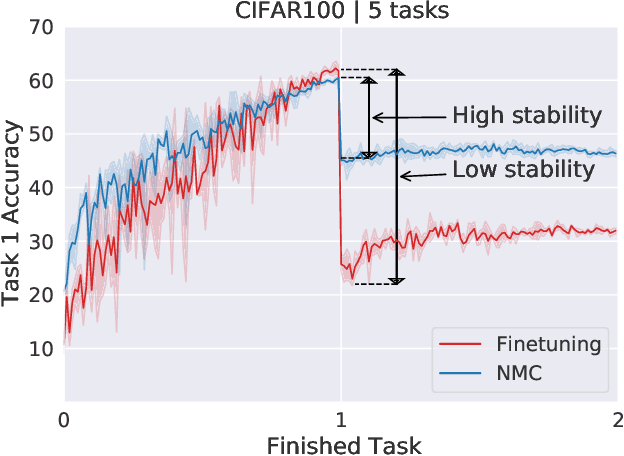
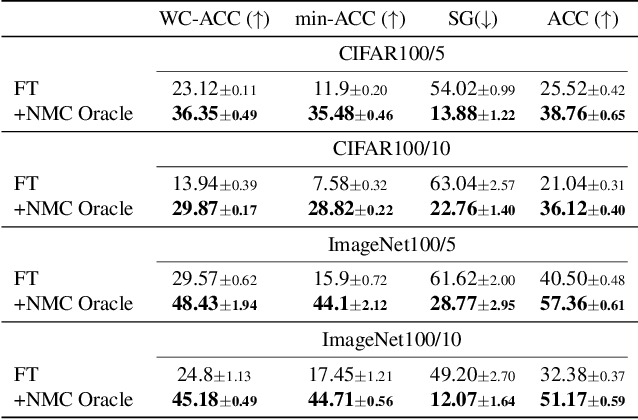

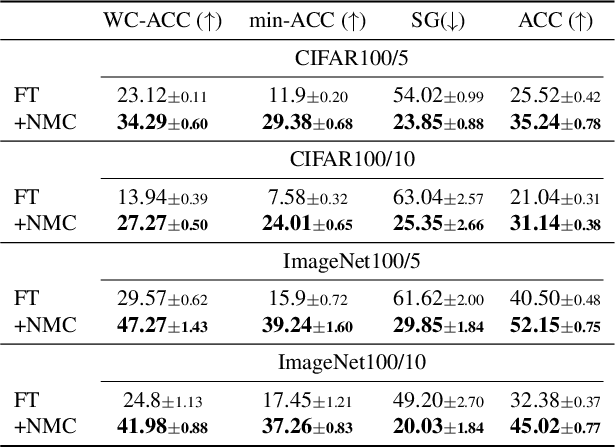
Abstract:Continual learning (CL) has emerged as a critical area in machine learning, enabling neural networks to learn from evolving data distributions while mitigating catastrophic forgetting. However, recent research has identified the stability gap -- a phenomenon where models initially lose performance on previously learned tasks before partially recovering during training. Such learning dynamics are contradictory to the intuitive understanding of stability in continual learning where one would expect the performance to degrade gradually instead of rapidly decreasing and then partially recovering later. To better understand and alleviate the stability gap, we investigate it at different levels of the neural network architecture, particularly focusing on the role of the classification head. We introduce the nearest-mean classifier (NMC) as a tool to attribute the influence of the backbone and the classification head on the stability gap. Our experiments demonstrate that NMC not only improves final performance, but also significantly enhances training stability across various continual learning benchmarks, including CIFAR100, ImageNet100, CUB-200, and FGVC Aircrafts. Moreover, we find that NMC also reduces task-recency bias. Our analysis provides new insights into the stability gap and suggests that the primary contributor to this phenomenon is the linear head, rather than the insufficient representation learning.
Task-recency bias strikes back: Adapting covariances in Exemplar-Free Class Incremental Learning
Sep 26, 2024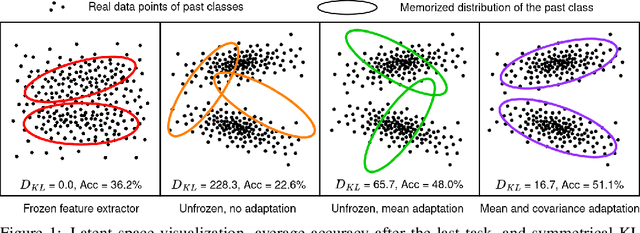
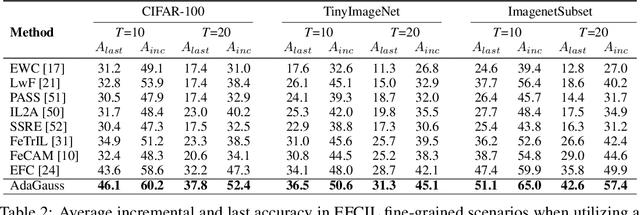


Abstract:Exemplar-Free Class Incremental Learning (EFCIL) tackles the problem of training a model on a sequence of tasks without access to past data. Existing state-of-the-art methods represent classes as Gaussian distributions in the feature extractor's latent space, enabling Bayes classification or training the classifier by replaying pseudo features. However, we identify two critical issues that compromise their efficacy when the feature extractor is updated on incremental tasks. First, they do not consider that classes' covariance matrices change and must be adapted after each task. Second, they are susceptible to a task-recency bias caused by dimensionality collapse occurring during training. In this work, we propose AdaGauss -- a novel method that adapts covariance matrices from task to task and mitigates the task-recency bias owing to the additional anti-collapse loss function. AdaGauss yields state-of-the-art results on popular EFCIL benchmarks and datasets when training from scratch or starting from a pre-trained backbone. The code is available at: https://github.com/grypesc/AdaGauss.
TabMixer: Noninvasive Estimation of the Mean Pulmonary Artery Pressure via Imaging and Tabular Data Mixing
Sep 11, 2024Abstract:Right Heart Catheterization is a gold standard procedure for diagnosing Pulmonary Hypertension by measuring mean Pulmonary Artery Pressure (mPAP). It is invasive, costly, time-consuming and carries risks. In this paper, for the first time, we explore the estimation of mPAP from videos of noninvasive Cardiac Magnetic Resonance Imaging. To enhance the predictive capabilities of Deep Learning models used for this task, we introduce an additional modality in the form of demographic features and clinical measurements. Inspired by all-Multilayer Perceptron architectures, we present TabMixer, a novel module enabling the integration of imaging and tabular data through spatial, temporal and channel mixing. Specifically, we present the first approach that utilizes Multilayer Perceptrons to interchange tabular information with imaging features in vision models. We test TabMixer for mPAP estimation and show that it enhances the performance of Convolutional Neural Networks, 3D-MLP and Vision Transformers while being competitive with previous modules for imaging and tabular data. Our approach has the potential to improve clinical processes involving both modalities, particularly in noninvasive mPAP estimation, thus, significantly enhancing the quality of life for individuals affected by Pulmonary Hypertension. We provide a source code for using TabMixer at https://github.com/SanoScience/TabMixer.
Realistic Evaluation of Test-Time Adaptation Algorithms: Unsupervised Hyperparameter Selection
Jul 19, 2024



Abstract:Test-Time Adaptation (TTA) has recently emerged as a promising strategy for tackling the problem of machine learning model robustness under distribution shifts by adapting the model during inference without access to any labels. Because of task difficulty, hyperparameters strongly influence the effectiveness of adaptation. However, the literature has provided little exploration into optimal hyperparameter selection. In this work, we tackle this problem by evaluating existing TTA methods using surrogate-based hp-selection strategies (which do not assume access to the test labels) to obtain a more realistic evaluation of their performance. We show that some of the recent state-of-the-art methods exhibit inferior performance compared to the previous algorithms when using our more realistic evaluation setup. Further, we show that forgetting is still a problem in TTA as the only method that is robust to hp-selection resets the model to the initial state at every step. We analyze different types of unsupervised selection strategies, and while they work reasonably well in most scenarios, the only strategies that work consistently well use some kind of supervision (either by a limited number of annotated test samples or by using pretraining data). Our findings underscore the need for further research with more rigorous benchmarking by explicitly stating model selection strategies, to facilitate which we open-source our code.
Joint or Disjoint: Mixing Training Regimes for Early-Exit Models
Jul 19, 2024Abstract:Early exits are an important efficiency mechanism integrated into deep neural networks that allows for the termination of the network's forward pass before processing through all its layers. By allowing early halting of the inference process for less complex inputs that reached high confidence, early exits significantly reduce the amount of computation required. Early exit methods add trainable internal classifiers which leads to more intricacy in the training process. However, there is no consistent verification of the approaches of training of early exit methods, and no unified scheme of training such models. Most early exit methods employ a training strategy that either simultaneously trains the backbone network and the exit heads or trains the exit heads separately. We propose a training approach where the backbone is initially trained on its own, followed by a phase where both the backbone and the exit heads are trained together. Thus, we advocate for organizing early-exit training strategies into three distinct categories, and then validate them for their performance and efficiency. In this benchmark, we perform both theoretical and empirical analysis of early-exit training regimes. We study the methods in terms of information flow, loss landscape and numerical rank of activations and gauge the suitability of regimes for various architectures and datasets.
Let Me DeCode You: Decoder Conditioning with Tabular Data
Jul 12, 2024



Abstract:Training deep neural networks for 3D segmentation tasks can be challenging, often requiring efficient and effective strategies to improve model performance. In this study, we introduce a novel approach, DeCode, that utilizes label-derived features for model conditioning to support the decoder in the reconstruction process dynamically, aiming to enhance the efficiency of the training process. DeCode focuses on improving 3D segmentation performance through the incorporation of conditioning embedding with learned numerical representation of 3D-label shape features. Specifically, we develop an approach, where conditioning is applied during the training phase to guide the network toward robust segmentation. When labels are not available during inference, our model infers the necessary conditioning embedding directly from the input data, thanks to a feed-forward network learned during the training phase. This approach is tested using synthetic data and cone-beam computed tomography (CBCT) images of teeth. For CBCT, three datasets are used: one publicly available and two in-house. Our results show that DeCode significantly outperforms traditional, unconditioned models in terms of generalization to unseen data, achieving higher accuracy at a reduced computational cost. This work represents the first of its kind to explore conditioning strategies in 3D data segmentation, offering a novel and more efficient method for leveraging annotated data. Our code, pre-trained models are publicly available at https://github.com/SanoScience/DeCode .
 Add to Chrome
Add to Chrome Add to Firefox
Add to Firefox Add to Edge
Add to Edge